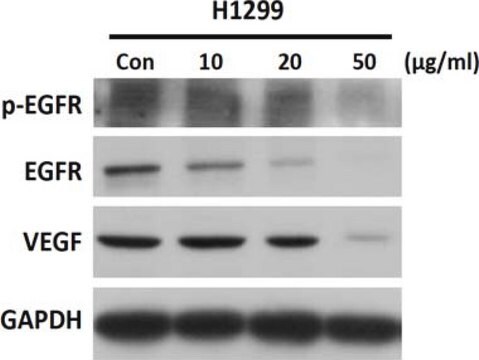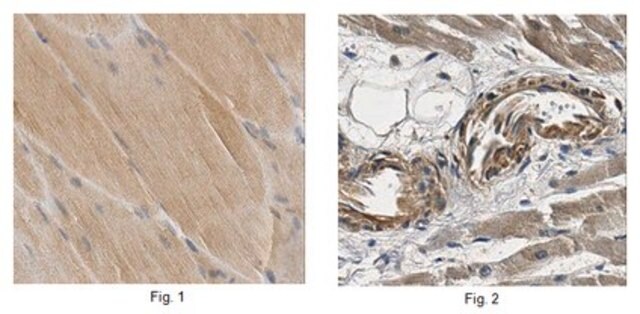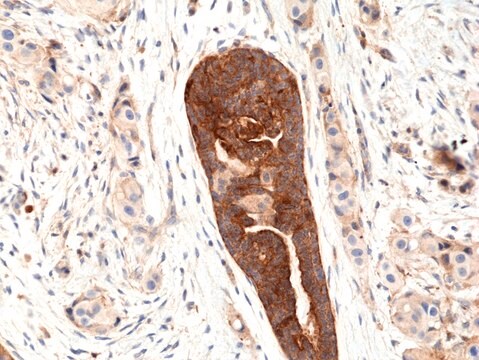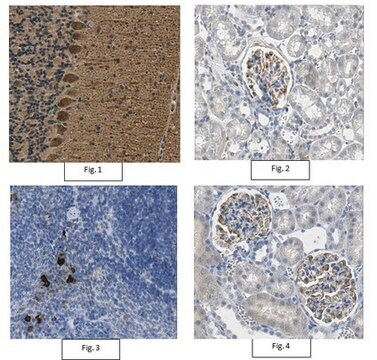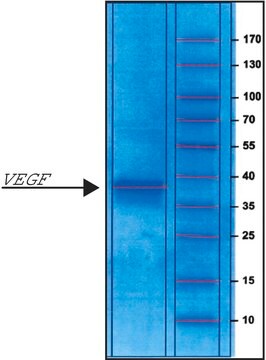MABC595
Anti-VEGF 165b Antibody, clone 56/1
clone 56/1, 1 mg/mL, from mouse
Sinónimos:
Vascular endothelial growth factor 165b, Vascular endothelial growth factor 165, Vascular endothelial growth factor A, Vascular permeability factor
About This Item
Productos recomendados
biological source
mouse
Quality Level
antibody form
purified antibody
antibody product type
primary antibodies
clone
56/1, monoclonal
species reactivity
human, mouse, rat
concentration
1 mg/mL
technique(s)
ELISA: suitable
immunohistochemistry: suitable
western blot: suitable
isotype
IgG1κ
NCBI accession no.
UniProt accession no.
shipped in
wet ice
target post-translational modification
unmodified
Gene Information
human ... VEGFA(7422)
General description
Immunogen
Application
Apoptosis & Cancer
Apoptosis - Additional
Immunohistochemistry Analysis: A 1:50 dilution of a representative lot detected detected VEGF 165b in tumor cells of human prostate cancer tissue.
Western Blotting Analysis: A representative lot detected recombinant VEGF 165b protein (Woolard, J., et al. (2004) CANCER RESEARCH 64:7822–7835).
Western Blotting Analysis: A representative lot detected VEGF 165b in human eye tissue lysate (Perrin, R.M., et al. (2005) Diabetologia. 48: 2422–2427).
Immunohistochemistry Analysis: A representative lot detected VEGF 165b in Mouse mesentery tissue (Woolard, J., et al. (2004) CANCER RESEARCH 64:7822–7835).
Immunohistochemistry Analysis: A representative lot detected VEGF 165b in tumor tissue sections (Peiris-Pagès, M., et al. (2010) Pathol. 222(2): 138–147).
ELISA: A representative lot of this antibody detected VEGF 165b by ELISA on tumor tissue samples & tumor cell lines (Peiris-Pagès, M., et al. (2010) Pathol. 222(2): 138–147).
ELISA: A representative lot of this antibody detected VEGF 165b by ELISA on recombinant protein VEGF 165b (Woolard, J., et al. (2004) CANCER RESEARCH 64:7822–7835).
Quality
Western Blotting Analysis: 2 µg/mL of this antibody detected VEGF 165b in 10 µg of NIH/3T3 cell lysate.
Target description
Additional uncharacterized bands may be visible in some lysates.
Physical form
Storage and Stability
Disclaimer
¿No encuentra el producto adecuado?
Pruebe nuestro Herramienta de selección de productos.
Storage Class
12 - Non Combustible Liquids
wgk_germany
WGK 1
flash_point_f
Not applicable
flash_point_c
Not applicable
Certificados de análisis (COA)
Busque Certificados de análisis (COA) introduciendo el número de lote del producto. Los números de lote se encuentran en la etiqueta del producto después de las palabras «Lot» o «Batch»
¿Ya tiene este producto?
Encuentre la documentación para los productos que ha comprado recientemente en la Biblioteca de documentos.
Nuestro equipo de científicos tiene experiencia en todas las áreas de investigación: Ciencias de la vida, Ciencia de los materiales, Síntesis química, Cromatografía, Analítica y muchas otras.
Póngase en contacto con el Servicio técnico